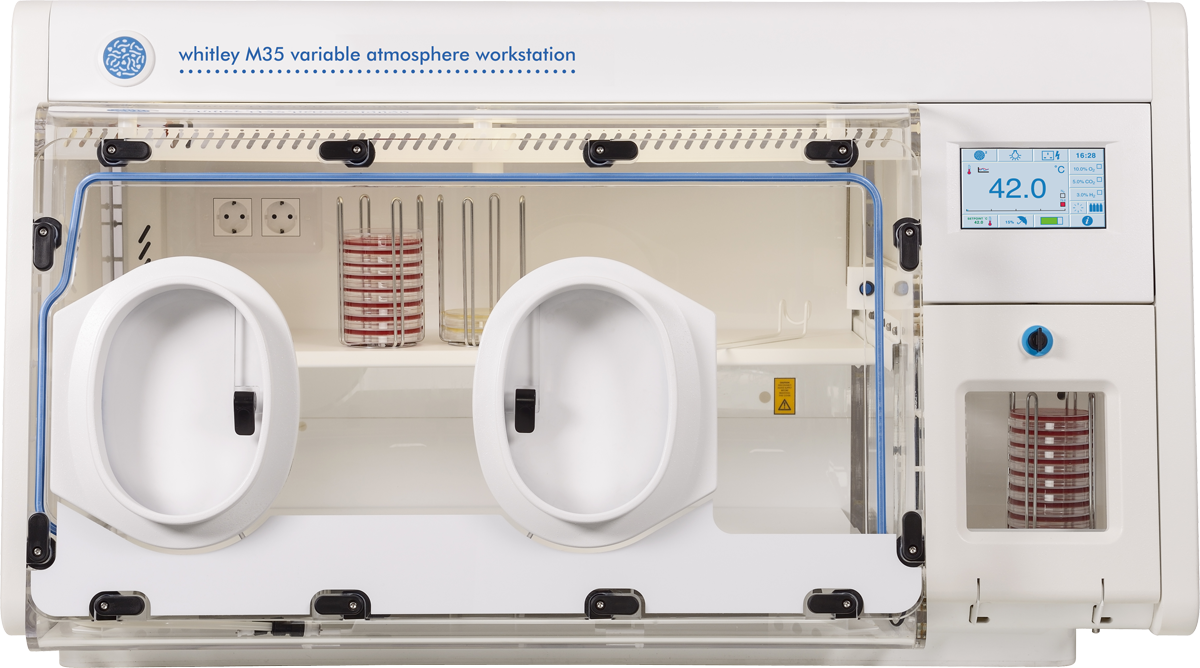
Whitley Microaerobic Workstations are designed for isolation, culture, and manipulation of microaerophiles, which are microorganisms that require oxygen to survive, but at a concentration less than that present in atmospheric air. Since these microaerophiles grow poorly in ambient oxygen levels and in anaerobic conditions, microaerobic workstations are ideal as they allow easy manipulation of oxygen levels to optimise growth.
Helicobacter pylori is one of the many microorganisms that has been successfully grown and isolated in a Whitley Microaerobic Workstation. It is a Gram-negative rod that resides in the stomach of approximately 50% of people [1]. In >90% of infected persons, H. pylori is a harmless commensal [4], but in some cases, the bacteria can travel to and damage the columnar epithelial cells of the stomach leading to gastric and peptic ulcer disease [1]. This is characterised by abdominal pain, nausea, vomiting and indigestion [1]. Infection with H. pylori is also associated with gastric cancer and it is, therefore, an important organism to study [1].
 Disease caused by H. pylori can be diagnosed by culture of gastric biopsy specimens. Current guidance [2] specifies that gastric biopsies should be incubated at 35°C to 37°C in a microaerobic environment, at high humidity, in the presence of 3-5% H2. Plates should be incubated for a minimum of 10 days and inspected every 48 hours. Whitley Microaerobic Workstations can achieve these conditions using a 4-gas system with oxygen, carbon dioxide and hydrogen sensors. Precise gas concentrations and humidity can be programmed, producing optimal conditions for working with specimens and cultures in a sustainable microaerobic environment.
Disease caused by H. pylori can be diagnosed by culture of gastric biopsy specimens. Current guidance [2] specifies that gastric biopsies should be incubated at 35°C to 37°C in a microaerobic environment, at high humidity, in the presence of 3-5% H2. Plates should be incubated for a minimum of 10 days and inspected every 48 hours. Whitley Microaerobic Workstations can achieve these conditions using a 4-gas system with oxygen, carbon dioxide and hydrogen sensors. Precise gas concentrations and humidity can be programmed, producing optimal conditions for working with specimens and cultures in a sustainable microaerobic environment.
Written by DWS microbiologist Kirsty McTear
References
- S. Parikh N, Ahlawat R. Helicobacter pylori. StatPearls; 2021. Available from: www.ncbi.nlm.nih.gov/books/NBK534233/
- NHS PHE. UK standards for microbiology investigations [Internet]. Investigation of infectious causes of dyspepsia. 2019 [cited 2023Apr21]. Available from: https://uksmi.github.io/Standards-for-Microbiology-Investigations/bacteriology/B_55i7.pdf
- NHS PHE. UK Standards for Microbiology Investigations [Internet]. Identification of Helicobacter species. 2015 [cited 2023Apr21]. Available from: ID 26 - Identification of Helicobacter species (publishing.service.gov.uk)
- Bytzer P, Dahlerup JF, Eriksen JR, Jarbøl DE, Rosenstock S, Wildt S (2011). Diagnosis and treatment of Helicobacter pylori infection. Danish Medical Bulletin 58 (4)


 en
en

 xEnglish
xEnglish